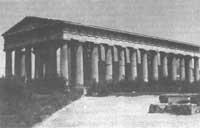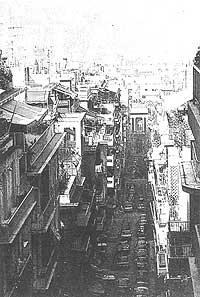Athens: a huge ecological catastrophe

At least one thousand three hundred people died in Greece due to the warming of the last summer, of which about a thousand two hundred were residents in Athens. Thermometers announced 50°C and remained for a week at around 40°C.
Many factors have aggravated the damage caused by the rise.
Athens suffers more intense pollution than the rest of European cities, due to industrialization and anarchic traffic.
There is no urban plan, the bureaucracy is huge and the management of medical resources is null. In reality these are serious problems that burn when the exaggerated population is like that of Athens: in the capital there are 3 million inhabitants, 1600 inhabitants per hectare or 16 people per 100 m 2.
Despite the fact that in a report published ten years ago by the world health organization touched six alarm numbers, it has continued to be built without paying attention. Buildings are everywhere and cause serious climbs. To begin with, the wind blows slowly, avoiding the atmospheric currents under the layers of stable air, and not only that, but the materials in which they are built retain the heat.
It is a well-known and widespread phenomenon, which in most cities is hotter than the towns around them. For example, the trees in the cities bloom 8 to 12 days before those in the surrounding area. This 8 day difference is due to an approximate temperature of 1º C. In Paris, for example, this thermal anomaly is increasing: In it, every year Ille de France exceeds 1.7 ° C to the rural area. Or in other words, it is as if in 50 years Paris had moved 170 km south.
In Athens the trend of concentration is even greater and this phenomenon is more serious. But this is not perceived by early tree blooms, as there are no trees. Green areas not disappeared by politicians occupy more than 3.6% of the urban area. In some neighborhoods, like Kallithea, they don't even reach the size of a handkerchief.
It is a very serious problem. These spaces play a fundamental role. But not because of the widespread idea that plants act as the lungs of cities. In a very simplistic way, photosynthesis has considered plants to purify air as they eliminated carbon dioxide and emitted oxygen. But oxygen occupies a fifth of the volume of the atmosphere and the contribution of plants is not so important in a city. Fluctuations in carbon dioxide are very vulnerable to health.
The influence of plants on many other pollutants and temperature is fundamental. And precisely in Athens this error has been costly. A tree has the same freshness capacity as 10 air conditioners. Trees reduce temperature, cause air currents and resist drying. In six months a hectare of marshes sweat 3,000 tons of water (another thing is that this type of trees are not the most suitable for the climate and soil of Athens, but there are other appropriate species).

Along with evapotranspiration occurs the absorption and decrease of calorie. A 50-100 m long vegetable band, as in the urban core, can cause a rise of 3-4°C and a 50% increase in humidity. The differences thus obtained sound hot air above the constructed areas, generating mini-pressures that are sufficient to produce 12 km/h of growth and regenerate the air of a large city in an hour.
This is very important. In fact, the air that descends, circulating above the plant islets, will tend to fight against the pollution domes that form over the hottest urban areas. In addition, this decreasing air current will precipitate dust particles in suspension into the ground in many cities at alarming rates. They are thousands of particles that attack people's lungs and turn the natural pink color of the skin into a grayish. In this sense, at different points in the city of Frankfurt, measurements per liter of air show differences: 184,000 particles in urban environment, 115,000 in treeless walks, 38,000 in avenues with modified trees, 31,000 in parks, etc...
Therefore, they are huge natural filters. One hectare of forest is capable of annually removing 4 tons of dust from the atmosphere. The 50-100 m long vegetable screen reduces air dust by half. After precipitating to the ground, dust particles are fixed on the plants. Trees are our best friends in the war against these dust particles. A simple lawn treads 3-6 times more than a grassless surface and a tree 30-6 times more.
This fixing capacity is different according to the species: In 15 days in Paris they have been collected in 100 g of wicker leaves 2,735 g of powder, in those of chestnut 2,295 g, in those of sofora 0,996 g, in those of pterocarys 0,979 g and in those of stem 0,936 g. This means that it is impossible to throw tons and tons of dust to the trees and think that they will remain without any harm. If pollution is high, it will affect photosynthesis and these trees can die. However, plants also have the ability to restore their ancient organs and especially their leaves.
The qualities of plants are not just those. They also have bactericidal action. Its leaves secrete substances with antibiotic properties, that is, phytoncides. They are phenolic compounds, like tanins and terpenes, which are emitted into the atmosphere on the surface of the leaves and volatile in the particles. Although the absorption capacity of toxic gases by plants has been a widely discussed topic, we will not mention it here. The ability of green areas to reduce or eliminate pollution domes caused by this gas gives them sufficient merit.
In short, plants (and especially trees) refresh, humidify and collect dust. Therefore, for maximum efficiency, it is advisable to change it in the right environment. Small spaces lost between buildings will not improve the state of the air, but will act as dust vacuum cleaners. That's why it's crazy to tell kids to play there, because the fresh drafts they generate are like a funnel that absorbs the air masses around them.
The design of the ideal city should be: surrounded by forests and crossed by radial green cuts. Some Dutch cities and the Austrian city of Vienna approach this scheme. But not unfortunately the city of Athens, where accumulated pollution and heat have caused the death of the most vulnerable people.





